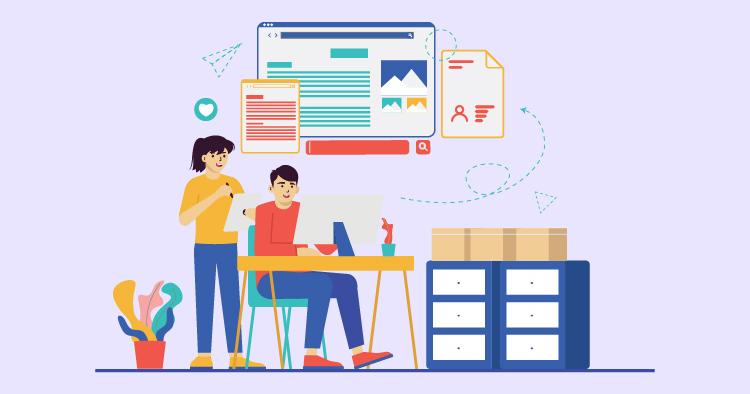Web development is like a team sport where everyone plays a crucial role. Imagine you’re building a website or a web application. You’ll need front-end developers like the artists and architects to ensure everything looks great and works well for the users. Then there are the back-end developers–think of them as the engineers who keep the engines running behind the scenes, managing data and server operations. Full-stack developers are versatile players who can jump in on both sides, tying the front and back ends together seamlessly. Some specialists handle databases, ensuring they organize data neatly, and those who work on content management systems enable people without a tech background to update website content easily. This article will dive into these different areas of web development, breaking down what each one does and how they all contribute to the smooth running of our digital experiences.
Static Websites
Static websites serve as straightforward online representations for businesses or individuals. They comprise web pages with fixed content coded in HTML, CSS, and sometimes JavaScript. Each page is a separate document with no database from which it draws. This means that the content shown to visitors is the same across the board, and any updates require manual changes to the code by a web developer.
These sites are helpful for small businesses because they are easier to create and manage. They’re also faster to load since they don’t need to retrieve content from a database or execute complex server-side scripts. Plus, hosting is more straightforward, which can also help to minimize costs. A static website can be a perfect fit for businesses that need an online presence to share information, like a local restaurant’s menu or a freelancer’s portfolio.
However, the simplicity of static websites comes with limitations, such as the inability to offer personalized content or interactive features that a dynamic website can provide. This could make it harder for a business to engage with customers online beyond providing basic information.
Dynamic Websites
Dynamic websites are full of features and built to interact with users. Thanks to server-side scripting languages like PHP, Python, and JavaScript frameworks, they adapt and change their content based on user interactions. Databases connect these sites and store all the content and data that the website displays and manages.
Small businesses can benefit from dynamic websites if they need to offer a more engaging user experience. These sites can handle user profiles, comments, and personalized content—features that make a website more interactive and responsive to visitors. They also make it easier for business owners to update content through a backend interface without touching the codebase.
The trade-off is that dynamic websites usually require more resources. They can be more costly to set up and maintain because of their complexity, and they might need more advanced hosting services to ensure they run smoothly.
Dynamic websites are a go-to for businesses like online stores, interactive blogs, or social networks—essentially, any site that needs to update content regularly and engage with its audience on a deeper level.
Select one of over 500 designs and establish your online presence.
- Free Web Hosting
- Fully Managed Solutions
- Scalable Websites
- No Hidden Cost
Content Management Systems (CMS)
Content Management Systems (CMS) are tools that simplify building and managing a website. They’re designed so that even those without coding experience can easily create, edit, and manage website content. A CMS is a behind-the-scenes platform that provides a straightforward way to handle a website’s content through a user-friendly interface.
Small businesses often choose popular CMS platforms like WordPress, Joomla, or Drupal. Small businesses usually prefer these platforms because they offer a range of templates and plugins that make it easy to customize a site’s look and functionality. And functionality. They’re also scalable, meaning they can grow with a business and have potent communities around them offering support and resources.
The primary advantage of a CMS is that it allows business owners to keep their website up to date without knowing how to code. Using a CMS allows business owners to save time and money while maintaining a professional online presence that can be expanded with additional features like online stores, forums, or customer service portals as the business grows.
E-commerce Websites
E-commerce websites are like online stores where you can buy and sell products or services. They’re helpful for small businesses that want to reach more customers and take advantage of the trend of more people shopping online. These websites let companies showcase their products, handle payments, and manage orders all in one place.
Some of the main things you’ll find on an e-commerce website include a list of products (product catalog), a shopping cart for customers, ways to pay (payment gateways), and tools to keep track of customers. These features must work together to make shopping easy and enjoyable for customers.
If you’re considering starting an online store, you must pick the right platform to build your store on, ensure that transactions are safe, make the site easy to use on phones and tablets, and give excellent customer service. To do well in the competitive world of online shopping, pay attention to making the site easy to use, keeping it secure, and having good marketing.
Responsive Web Design
Responsive web design is about making websites look and work great on any device, whether a phone, tablet, or computer. This design adjusts the website’s layout to fit different screen sizes using flexible grids, images that can stretch or shrink, and rules that tell the website how to look on different devices (media queries).
For small businesses, having a responsive website is crucial because it means that customers will have an enjoyable experience no matter how they visit the site. This can lead to more people staying on the site longer and returning more often. Plus, websites that work well on mobile devices show higher search results, which can help more people find the business.
Websites that are easy to use on all devices are more likely to keep users happy, which can lead to them spending more time on the site and not leaving quickly (which is good for SEO). So, responsive design is not just about looking good—it can also help get more visitors from search engines.
Select one of over 500 designs and establish your online presence.
- Free Web Hosting
- Fully Managed Solutions
- Scalable Websites
- No Hidden Cost
Custom Web Development
Custom web development means creating a website just for your business. It’s great because you can get precisely what you need, make your website stand out with a unique design, and add special features. It’s also suitable for businesses that plan to grow because you can add additional parts to the website.
However, custom development can be expensive and take longer than ready-made templates or platforms. It involves many steps—planning, designing, building, and testing—which can take time and effort.
Small businesses might want custom development if they have special needs that off-the-shelf options can’t meet, want something unique, or need a website that can grow with them. Custom development means investing in a website that’s just right for your business and can change as you do.
Front-End Development
Front-end development is about creating the parts of a website that users interact with directly. It’s what makes a website not just functional but also enjoyable to use. The goal here is to make the user’s experience smooth and intuitive.
Developers in this field use multiple tools to bring websites to life, such as HTML for the basic structure, CSS for layout and design, and JavaScript for adding interactivity. These are the building blocks of web design. Developers widely use frameworks like React, Angular, and Vue.js because they offer ready-to-use components that make it easier to build complex features.
The way a website looks and feels is hugely important. It’s the first thing users notice, and it can make or break their experience. A well-designed front end can help users navigate the site better, find information faster, and complete tasks without frustration. Therefore, front-end development is crucial – it directly affects how users perceive a website and, by extension, the business or organization it represents.
Back-End Development
Back-end development is like the behind-the-scenes crew of a website. This part of development focuses on the server, database, and application logic—all the things that work in the background to ensure the site runs smoothly and securely.
The languages used here differ from those used in front-end development. Developers might use PHP, Ruby, Python, or Java, and they often rely on frameworks like Node.js, Django, or Ruby on Rails to help structure their code and build robust applications.
The back end is the part of the website that does the heavy lifting. It’s responsible for storing and organizing data, ensuring users are who they say they are (authentication), and handling tasks like processing payments or searching for content. Without a solid back end, a website might look nice, but it won’t be able to do much.
Full-Stack Development
Full-stack development is for those who like to work on both front-end and back-end. Full-stack developers have a broad skill set that covers everything from a website’s visual aspects to complex server-side processes.
These developers are jacks-of-all-trades, comfortable working with the code a user interacts with and the databases that store the user’s information. They’re familiar with multiple programming languages and frameworks and often have a good grasp of web design principles.
A full-stack developer on a team can be precious, especially for smaller businesses. They can oversee the entire development process, from start to finish, making things more efficient. But, because they split their attention between front-end and back-end tasks, they might not have the same expertise in a specific area as someone specializing in just one.
Freelance Web Developers vs. Web Development Agencies
When you’re looking to get a website built or updated, you might choose between hiring a freelance web developer or working with a web development agency. Freelance developers are often a go-to for those looking for a more personal touch. They can be more flexible with their time and may offer lower prices than larger companies. However, a freelancer might not have all the resources or an array of skills that you need for your project.
Web development agencies bring a team to the table. This means you get unique skills and experience, all under one roof. They’re more equipped to undertake extensive projects and can offer ongoing support after your website runs. While this might cost more, it could be a worthy investment if you need a complex site or plan a large-scale project.
As a small business owner, think about what you need from your website, how much you can spend, and how much hand-holding you’ll want during the process. This will help you decide whether a freelancer or an agency better fits your project.
Outsourcing vs. In-House Web Development
Whether to outsource or keep web development work in-house is a big decision. Outsourcing can save you money and give you access to a wide range of talents worldwide. It’s also flexible, so you can scale your team up or down as your project requires. This can be a smart move if you can not build and manage a web development team within your company.
But outsourcing isn’t without its challenges. You might face difficulties with communication, especially if you’re working with people in different time zones. Plus, it’s hard to keep a close eye on the quality of the work when the team isn’t right there with you.
Having an in-house development team means you can work closely with them, ensuring they’re in tune with your company’s goals and culture. This can lead to better collaboration and results closely aligned with your vision. However, it’s a significant commitment to hiring, training, and managing staff.
Before making a choice, consider the size and duration of your web development projects, your budget, and how important it is for you to have direct oversight of the development process. Outsourcing can be great for one-off projects or when you need specific expertise that you don’t have in-house. But if you’re looking at long-term development needs that require constant attention, having an in-house team might serve you better.
Final Thoughts
Understanding the different flavors of web development can be super helpful. If you’re a business owner needing a website, it helps you know who to hire. If you’re considering a tech career, it can guide you on which path to pursue. Each type of web development has its preferred tools, languages, and frameworks, so it’s crucial to match your project with the right expertise. And with technology constantly advancing, there’s always something new to learn in web development. This keeps the field exciting and means those eager to learn will always find opportunities to grow and succeed.



